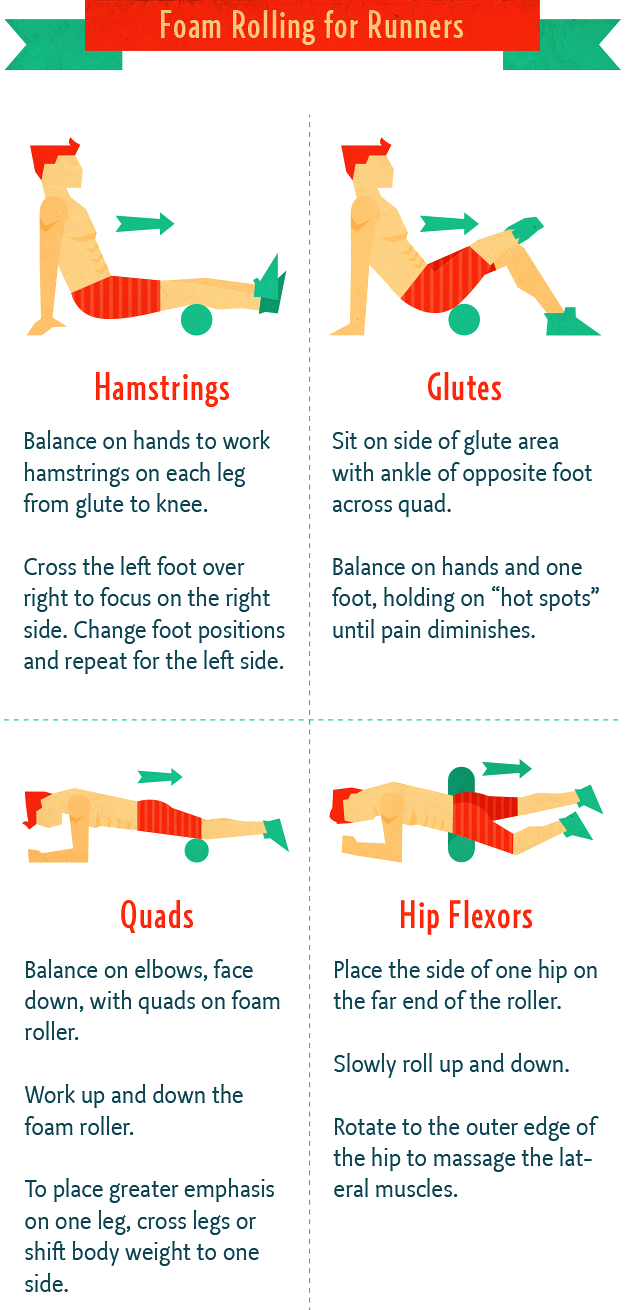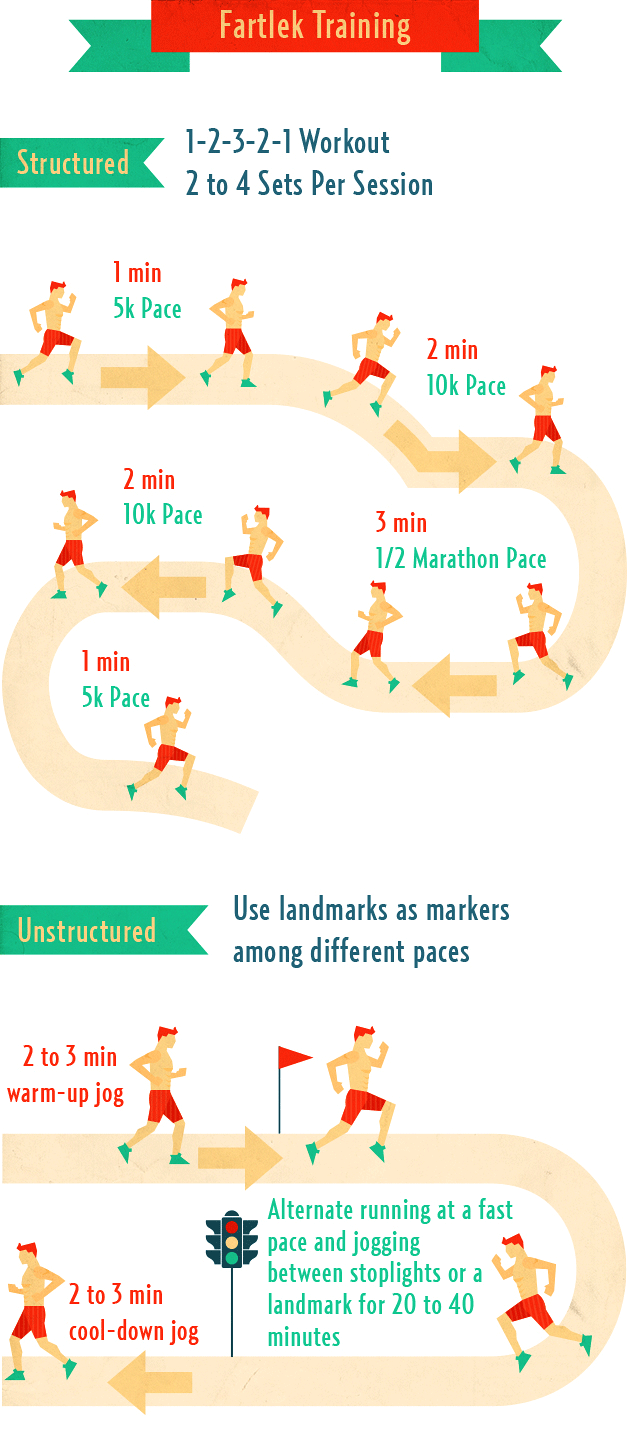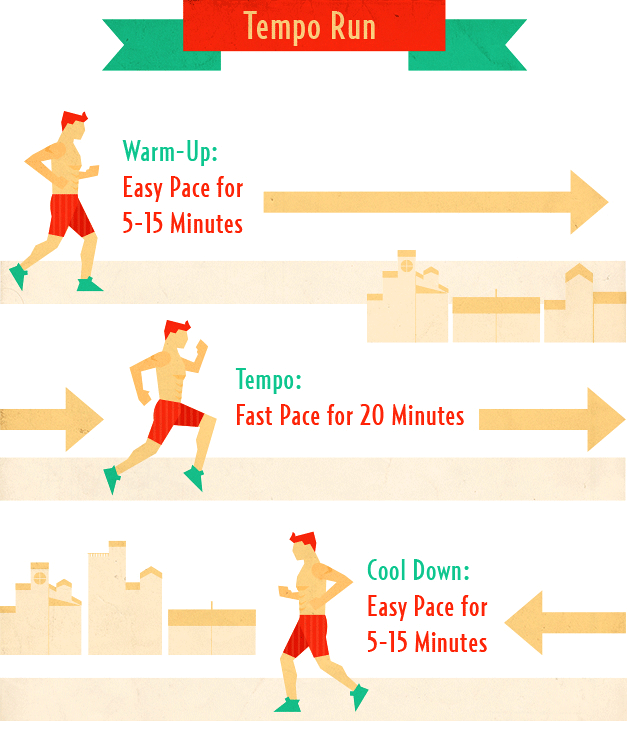WRITTEN BY
Nicole is a wellness and fitness enthusiast with a background in journalism and nutrition. Her work has been featured in USA Today, Men’s Fitness, and The Huffington Post among others.
Nicole McDermott's Author ProfileNicole McDermott's Google Plus Page No matter the distance—5K, 10K, half-marathon, or a full 26.2 miles—whittling down your time and getting faster is often a runner's goal. Shaving minutes or even seconds off a race time may feel close to impossible. However, there are science-backed methods (combined with a little hard work and determination) to morph into a speedier version of yourself. From strength training and focusing on the core to recovery techniques and catching enough shut eye, we've compiled 19 tried and true ways to get you from the start to the finish line in less time.
Breathe right
Focus on deep belly breaths. 1 Envision your stomach as a balloon. Every time you breathe in it should inflate and every time you breathe out it should deflate. Once you've got that deep, even breathing down pat, you can use more energy to focus on running rather than the less-effective huffing and puffing. HIIT it
High intensity interval training (HIIT) helps build speed and endurance by increasing aerobic capacity. 1 Rather than focusing on long, steady static runs every day, switch things up with alternating periods of high-intensity effort and periods of lower-intensity work (a.k.a. the recovery). The short rests after quick, intense bursts may gradually increase your ability to run faster for longer. 1 Roll it out
Foam rolling—also known as self-massage, or self-myofascial release—relies on a tube-like tool to help loosen tight muscles, improve flexibility, and increase range of motion (especially in the knees). 2 Foam rolling can also help prevent the buildup of scar tissue and reduce pain in running-specific muscles like the quads, hamstrings, and calves.3 Beyond all those benefits, a few sessions with a foam roller per week can help prevent injury and speed up recovery, which are two of the sneakiest, best ways to improve speed.  Source: Multiple Uses of Biofoam Rollers
Source: Multiple Uses of Biofoam Rollers Speed play
While the name may give you the giggles, fartlek training (Swedish for speed play) is a fun way to play with high intensity intervals, minus the clock-watching structure. 4 Once you warm up, alternate fast periods with slower, easy-effort running. Instead of timing each interval to the second, have fun and challenge yourself by running to specific landmarks (i.e. a certain tree or mailbox).  Source: Workout Of The Week: Brad Hudson's 1-2-3-2-1 Fartlek
Source: Workout Of The Week: Brad Hudson's 1-2-3-2-1 Fartlek Beef up
Picking up a pair of dumbbells, a medicine ball, a kettlebell, or a barbell for weight training can help lower your race time outside of the gym. Research shows resistance training has a positive effect on endurance running performance. 5 Why? When runners up their mileage, muscles that aren't ready for increased intensity are more prone to injury. 6 Training with weights can increase range of motion, prepare muscles for a bump in intensity, and improve posture and endurance. Build a core of steel
Strengthening your core—abdominals, hamstrings, glutes, hips, back, and obliques—is an effective method to improve stability, speed, and overall performance. 7 8 Best of all, a strong core can help runners hold proper running form longer. Head to the hills
Running hills increases intensity and reduces risk of injury, thanks to decreased joint impact. Running, jogging, or even walking up hills develops muscle fibers, but the key is to gradually increase the length and steepness of hills.9 Grab a cup of joe
Caffeine has long been associated with improvements in running performance and speed. 10In one study, just 3 grams of caffeinated coffee enhanced runners' speeds during a high intensity 1500 meter run. 11 Since caffeine absorbs quickly, you can drink a cup of coffee close to the start of a run. Take it to the mat
Just as foam rolling can decrease running times by improving flexibility, yoga can be an effective way to stretch out tight muscles and improve strength, balance, and coordination. Yoga also teaches pranayama, or breath work—the belly breathing we talked about earlier. 12Taking yogic breathing from the mat to the pavement can help runners control the body and help a run feel less demanding. 13 Sleep plenty
Research suggests just one night of sleep deprivation can have negative affects on endurance performance and pacing. 14 Adequate sleep can help speed recovery after tough runs because our muscles repair while snoozing. So do what you can to get into a regular, relaxing bedtime routine. 15 If mid-afternoon coffee keeps you from falling asleep with ease, skip it. If you find late-night TV keeps your motor going, shut off the tube earlier. Shoot for the sleep sweet spot of seven to eight hours a night. Bump up your cadence
Cadence—also known as stride rate—is measured by how many times both feet make contact with the ground. 16 Next time you head out for a run, count the number of steps you take in 20 seconds (count each time your right foot hits the ground). Multiply that number by three and you've got your cadence. Keep track of your cadence on each run (just count once, no need to go crazy) and work to increase your steps per minute over time. Remember, your jogging cadence will be lower than your race-speed cadence. Lose some pounds
Think back to high school: Chances are your book-filled backpack was unbearably heavy. Running to class and climbing stairs with a backpack was no doubt more challenging than without the extra weight. The same principle is true for running: The fewer pounds you have to lug around, the faster you could go (for every pound lost, a runner could cut about two seconds off his or her mile time). 17 Though simple physics say most of us will run faster if we shed a few pounds, it doesn't mean all of us should take on a massive weight loss journey. If you're already on the slender side, losing weight could mean muscle loss, too. Ditch extra gear on race day
Stripping down won't shave minutes off your race time. But, just like losing a few pounds can have a positive effect, it's helpful to wear just what you need on race day. Make time for the “Dreadmill”
Yah, yah, we know: Most runners dread the treadmill. But, treadmill running has benefits. Without roadblocks (i.e. stoplights), running on a treadmill is a great way to stick to a set and monitor a pace. Plus, the treadmill is a boon during bouts of inclement weather. Prioritize tempos
While on the topic of the dreaded treadmill, let's talk about tempo runs. This training involves setting your pace at a slightly faster speed than comfortable—not necessarily a full-on sprint, but a tad speedier than normal. While interval runs, strength training, and varying your routine are all important and effective ways to run faster, tempo runs are a great way to prepare for longer races. In one study, runners who incorporated tempo and interval runs (plus running more miles per week) ran significantly faster than those who didn't up their mileage and run both tempo and interval. 18 Shoot for two to three miles per tempo run (not including warm-up and cool-down) if training for shorter races and four to eight miles for half-marathon and marathon distances. 19  Source: Summer Training For Fall Running
Source: Summer Training For Fall Running Skip, jump, and hop
Plyometrics—quick, explosive exercises that include jumping, hopping, and skipping—are an awesome way to strengthen leg and foot muscles. 20 Studies show runners, especially sprinters, who incorporate plyometrics into their weekly routines see improvements in speed.21 22 Keep in mind that plyometrics, including popular moves like squat jumps and box jumps, can definitely increase a runner's risk of injury, so incorporate a plyo workout just once a week. Add miles
To get faster, sometimes the simplest (and, in some ways, the most difficult) way is to tack on more miles. 23 But, it's important to note that running too much will increase your risk of injury. In general, a good guideline to follow is a mile extra for every run per week (for example, four extra miles if you run four times weekly). Maintain the added mileage for two weeks before tacking on even more miles. Carbo load
While there's no need to wolf down a box of pasta or a baguette before every run, research does show that consuming foods high in carbohydrates a day or two before a race may increase runners' endurance for long runs—we're talking marathon-length .24 Don't get hurt, darn it
If you overdo it and get injured, you may have to toss your running shoes in the closet for a few weeks or more. Take care of your body, get lots of sleep, and strength train for strong, healthy ready-to-run muscles. Source:
Fix.com Sources:- http://www.runnersworld.com/running-tips/lung-power
- http://www.active.com/fitness/articles/2-interval-training-plans-to-build-speed
- http://www.nhs.uk/Livewell/c25k/Pages/interval-training-running.aspx
- http://www.usatriathlon.org/about-multisport/multisport-zone/multisport-lab/articles/foam-rolling-102511.aspx
- http://www.running-physio.com/foamroller/
- http://www.runnersworld.com/race-training/whats-difference-between-fartlek-tempo-and-interval-runs
- http://www.ncbi.nlm.nih.gov/pubmed/18978605
- http://www.runnersworld.com/race-training/lift-or-not-lift-why-runners-should-strength-train?page=single
- http://www.active.com/running/articles/13-essential-core-exercises-for-runners
- http://www.ncbi.nlm.nih.gov/pubmed/19077735
- http://www.runnersworld.com/race-training/mastering-hill-workouts
- http://www.nutritionandmetabolism.com/content/10/1/71
- http://www.ncbi.nlm.nih.gov/pubmed/1623356
- http://www.mindbodygreen.com/0-4802/3-Powerful-Pranayama-Breathing-Exercises.html
- http://www.runnersworld.com/running-tips/running-air-breathing-technique
- http://www.ncbi.nlm.nih.gov/pubmed/19543909
- http://www.bodybuilding.com/fun/drobson5.htm
- http://runnersconnect.net/running-training-articles/heelstriking-running-cadence/
- http://www.runnersworld.com/weight-loss/quick-bites-will-losing-weight-help-me-run-faster
- http://www.ncbi.nlm.nih.gov/pubmed/23439344
- http://www.runnersworld.co.uk/general/the-perfect-tempo-run/3176.html
- http://www.artofmanliness.com/2010/05/21/beginners-guide-to-plyometrics/
- http://www.ncbi.nlm.nih.gov/pubmed/22240550
- http://www.ncbi.nlm.nih.gov/pubmed/12580657
- http://www.runnersworld.com/running-tips/how-many-miles-week-should-i-run